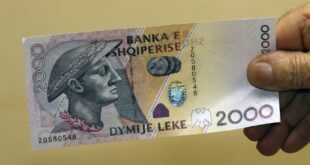More than two decades since it was burned down in the Bosnian Serb siege of the city, the Vijecnica, or City Hall, is preparing to reopen this summer.
Workers are still painting some of the interior of Sarajevo’s iconic City Hall in the final phase of restoration of the pre-war library.
Two million books, articles and magazines were burned in the fire caused by rockets fired by Bosnian Serb forces at the end of August 1992.
The Vijecnica was constructed in the Austro-Hungarian era and opened in April 1896. It served both as a city hall and as a library.
The building was originally designed by Alexander Wittek who died before it was finished and was succeeded by Ciril Metod Ivekovic.
Teams of architects and artists worked for years on the restoration in order to bring it back to its old state, carefully picking the right colours and the materials.
Muhamed Hamidovic, the main architect behind the restoration, last Friday said it was difficult to make the reconstructed complex look like the original since many drafts and plans were missing and the building had been all but destroyed in the fire.
‘There were problems in reading the colors of certain decorations but I think we got what we offer as our vision of the cultural-historic heritage,’ Hamidovic said.
Some of the decoration was completely destroyed and it was not known how the original colour was made, he explained.
The central hall in Vijecnica is surrounded by stone pillars while the ceiling is made of stained glass. Ceilings in the surrounding rooms have been painted in their original colours and style.
The City Hall was given to the City Council, which used it until 1949 when it was turned into a library. The valuable collection was a place where generations of Sarajevans studied and prepared for their exams.
The official end of work is set for July 4 but the exact date of the reopening has not been confirmed, although the Sarajevo City website calendar has set an event for May 9.
The EU delegation spokesman, Andy McGuffie, recalled that the EU had donated 9 million euro since 2000 for the restoration of Vijecnica while Austria, Spain, Bosnia’s Federation entity and the City of Sarajevo had also donated funds.
Restoration of Vijecnica’s outer facade finished in 2012, when the city regained one of its most distinctive, Austro-Hungarian landmarks.
On June 28, a concert of the Vienna Philharmonic is due to take place in Vijecnica as one of the events marking the centenary of the assassination of the Archduke Franz Ferdinand, the heir to the throne of Austria-Hungary, and his wife Sophie, on June 28, 1914.
Bosnia was then part of Austria-Hungary, and the Archduke’s assassination by a Bosnian Serb, Gavrilo Pincip, led to the outbreak of war between the Habsburg Empire and Serbia, when then drew in Russia, Germany, France, Britain, and others.
 Eurasia Press & News
Eurasia Press & News

